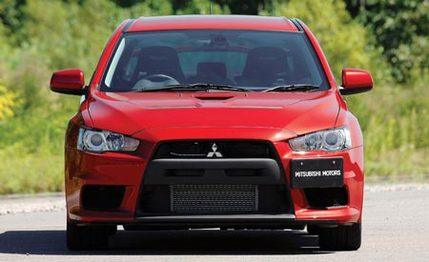
 First Drive Review
First Drive Review
Updating an automotive icon like the Mitsubishi Lancer Evolution is an unenviable task. After three generations and nine versions—only the last two have been sold in the U.S.—the ultimate interpretation of a rally-car-for-the-street theme is difficult to improve on, but it's also getting a bit old. To use the obvious pun, how can the Evolution evolve? The answer is here in the form of the 10th-version, fourth-generation car, known as the Evolution X in Japan. In the U.S. it will simply be called the Lancer Evolution, but for the sake of clarity, we'll use the Roman numeral that signifies all things extreme in referring to the car.
The Evo X is less communicative, larger, heavier, and slower compared with the previous Evo. It's the inevitable trade-off that occurs when a car strives for more refinement. The steering, for one, no longer has that high-tension-wire responsiveness that made the old car such fun. If you're an Evo fan boy, you can stop reading right now.
If you're still with us, you'll be glad to know that the Evo X drives like nothing else in the world. You simply point the car where you want to go, and the various elements of the all-wheel-drive system sort out how to make it happen.
As always, the Evolution is based on the standard Lancer sedan, and it still has a turbocharged 2.0-liter four-cylinder engine. But it's an all-new powerplant, designated 4B11. Design changes from the old 4G63 include an aluminum block rather than cast iron, a timing chain instead of a belt, and variable valve timing on the intake and exhaust camshafts. The power figures of 295 horsepower and 300 pound-feet of torque are bumps of 9 and 11, respectively, and the new engine is lighter by 27.5 pounds.
The body is lighter, too, thanks to the aluminum roof, hood, front quarter-panels, and front and rear bumper beams. The new suspension uses aluminum as well. But the weight saving is more than offset by the new car's stiffer structure and 1.6-inch-wider body.
The Evo is due here early next year and will come as the base GSR and the uplevel MR. The base price for the GSR should hover around $30,000; the MR will be at least $5000 more. The GSR comes with a new five-speed manual transmission, and the MR has Mitsubishi's new dual-clutch sequential transmission, dubbed Twin Clutch-SST (Sportronic shift transmission). The MR gets Bilstein shocks, lightweight Enkei wheels (each 2.1 pounds lighter), two-piece brake rotors (each 2.9 pounds lighter), chrome exterior trim, and optional navigation and leather seats.